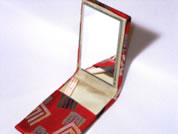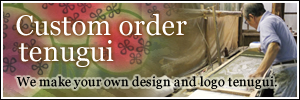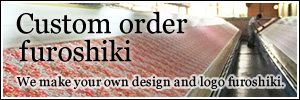Products brochure
Noren のれん
A Japanese noren is a textile article for hanging at a doorway and hallway. The history of noren dates back 1,000 years ago.
A noren is utilized for:
- Softening sunlight and wind coming into a room.
- Keeping privacy.
- Partitioning between a room and a hallway.
- Home décor and accentuation.
A noren usually has one or more vertical slits and is equally sectioned to let people pass easily. A noren has a rod pocket (enclosed type or loop type) sewed on the top, so that you can pass a noren curtain rail. We often refer a noren as a curtain, but to avoid a confusion, we would like to mention that a noren cannot be bunched up like a soft window curtain on the top. A noren is just a hanging textile.
A noren is also for a symbol and advertisement of a shop, a restaurant and a hotel. It is like a signboard. Shops hang their own logo noren at the front entrance. When you see a noren in front of a shop, it means the shop is open, and when you don't, it means the business hours are over. Since a shop hang a noren at an entrance for business, "noren" also means a brand.
A noren is often made from cotton, cotton/rayon-mixed, polyester or hemp. Cotton and cotton/rayon-mixed noren are softer, while polyester and hemp noren are harder. You can enjoy more colorful designs on polyester and cotton/rayon-mixed noren, while cotton and hemp noren designs are monotone and simple, but traditional and elegant. Contrary to design complexity, cotton and hemp noren are more expensive than chemical-fiber noren.
A noren is usually crafted 85 cm (33 1/2") or 175 cm (69") wide. This is because the standard doorway size of Japanese architectures is 90 cm wide and the standard size of a window door frame is 180 cm wide. So, it is very hard to find out a ready-made noren whose width is, for instance, 65 cm or 130 cm. Sorry to say, we cannot change the dimensions of noren.
Designs on noren are often lucky items and lucky words (what so called "power words", "power of language"). Japanese people believe lucky designs and words bring in fortune and healthiness to homes. Also similar in your country?
Please also take a look at our trials and demonstrations of noren hanging at apartments in NYC.

Furoshiki ふろしき
Furoshiki is a piece of square cloth for carrying items. There are variety of designs on furoshiki. The dimensions of furoshiki are typically from 50 cm (20") to 120 cm (47") square. Furoshiki are made either of cotton, silk, rayon or polyester.
Furoshiki is often used for gift wrapping to express sender's mind (Japanese saying: "wrap to deliver mind"). When people are invited as guests, they wrap gifts with furoshiki to the visiting place. Then, they unwrap furoshiki in front of the host or hostess, and the gifts are presented to him or her. By doing so, they try to express their attitude that they carry gifs with care and gratitude, and that they respect the visiting place. (Maybe, in most other nations, gifts will be unwrapped by recipients.)
Furoshiki may also be used for home decor or fashion.
Regarding the original meaning of Furoshiki, "Furo" means bath and "shiki" means spreading.
About 1,200 years ago when the steaming bath was prevalent in Japan, people spread Furoshiki and sit down on it in the steaming bath. About 400 years ago, Furoshiki were adapted in daily living for gift wrapping and carrying items.
Recently, Furoshiki is getting popularity to exercise 3R (Recycle, Reuse and Reduce) lifestyle instead of wasting huge amount of plastic bags.

"Tenugui" てぬぐい
Tenugui are one of the most typical Japanese traditional crafts with utilitarian and aesthetic purpose together. These thin woven cotton hand towels are dyed with wonderful designs and colors. They are beautiful as well as durable for everyday use.
"Te" means hands and "nugui" means wiping. Tenugui have been loved by Japanese people for over 1,000 years for wiping hands and face.
A tenugui's dimensions are typically 34 cm X 90 cm (13" X 35 7/16"). (Please be advised that tenugui are very thin, not so thick as western style towels.)
Tenugui can also be utilized for:
- Kendo Men head covering
- Fashion item (such as bandanna)
- Dish towel
- Table placemats
- Home decor
In Japan where the climate is humid, people prefer a thin tenugui that dries quickly to keep it sanitary. Although a tenugui is very thin, it absorbs lots of water. To let a tenugui dry quickly and also to lower the price, either end of tenugui is not hemmed. However, interestingly, fraying at the edges will stop after several washes.
The retail prices of tenugui in Japan are often from 800 to 2,000 Japanese Yen (approx. US$8 - US$20). However, elderly people think that tenugui are something that are given for free, because in the past, tenugui were distributed to neighborhoods by shops for advertisements.
People enjoy different design tenugui from season to season. Tenugui come in wide variety of designs. Designs are flowers, trees, birds, animals, insects, folktales, Ukiyo-e, traditional or contemporary motifs. Hundreds of designs are created each year and also are lasting for years. Tenugui are consumed by many people.
Nipponcraft.com mainly deals tenugui dyed with the traditional "Chu-sen" method. "Chu-sen" is an unique method whereby the dyes are poured over the surface of multiple cloths from a pitcher, and at the same time a vacuum pump set beneath sucks the dyes quickly. Chu-sen is quite different from a silkscreen printing. Chu-sen method was first invented by craftsmen in Osaka in the late 19th century. Chu-sen method enabled makers to produce inexpensive textile products for mass consumption.
Chu-sen tenugui does not have right and wrong sides to the design image. Both sides are beautifully dyed (double-sided). If you have a look at an automated silk screen or textile-ink printed tenugui, you can tell the clear difference of beauty. Chu-sen tenugui have more traditional feeling than 'printed' ones.
Only natural and non-toxic materials are used throughout the entire production process of Chu-sen method.
It is prevalent in Japan that shops, hotels, schools and many other organizations make their own logo tenugui for gifts and advertisements.
We will accept your custom order tenugui. We dye your design on tenugui with the Chu-sen method. For your custom order inquiry, please visit here.
Please enjoy tenugui! They are natural and non-toxic!
Please also see our tenugui demonstration in our pamphlet here.
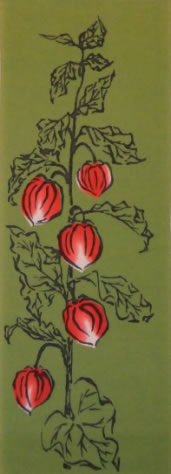
Zabuton (ざぶとん)
Zabuton is a Japanese style cushion for sitting used on Tatami-floor. It is almost square (often 55cm (21.7 inch) X 59cm (23.2 inch)) and has some thickness. In Japanese custom, when visitors come over to your house, the first thing to do is to provide Zabuton for sitting at a living room.
Zabuton can also be used for:
- Zen meditation
- a mat on a chair
- a pillow by folding it in half
A Zabuton is sold in Japan starting from 3,000 JPY at retail stores. As the price goes higher, the touch and the design get more luxurious.
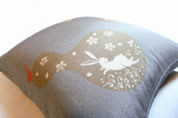
Gamaguchi-wallet (がま口)
Gamaguch is a wide opening wallet mostly carried by women in Japan.
"Gama" stands for frog and "guchi" stands for mouth. Gamaguchi is a wallet that looks like a frog opening its mouth. The wide-opening mouth makes it easy to put items in and out.
Gamaguchi has two metal fittings on the top that cross together for locking.
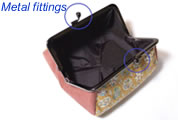
Kinchaku-bag (きんちゃく)
"Kin" means a slice of cloth and "Chaku" means carrying. Kinchaku is an "easy going" pouch. The Kinchaku pouch has been used in Japan since Edo era about 400 years ago.
A Kinchaku is a wallet and a handy pouch for carrying small items. Put small items into Kinchaku and just fasten the string on the top to hold. It's so convenient!

Kozeni-purse (小銭入れ)
This is the antique style coin purse. Fold in half and tie the purse with the attached string to hold. In this product, a five-Yen (5円) coin is attached to the string. The five-Yen is pronounced as "go-en", whose pronunciation is the same as that of "happy relation" (ご縁) in Japanese. 5円 (5 JPY coin) = ご縁(happy relation) in pronunciation.
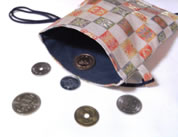
Sukiyabukuro-porch (数寄屋袋)
Sukiyabukuro is a simple pouch with a button on the top.
Literally, "Sukiya" means Japanese traditional tea ceremony room and "bukuro" means a pouch.
Traditionally, the Sukiyabukuro is a small pouch for going out to Japanese tea ceremony to carry necessary items such as a sensu folding fan and washi paper.
Alternatively, the Sukiyabukuro is convenient to carry cosmetics and cigarettes.
It’s so pretty to take Sukiyabukuro with you at a party!

Sensu (せんす)
Sensu is a Japanese traditional fan made of bamboo and washi paper. It is semi-circle shaped fan with the center angle of approximately 140 degrees when opened.
Since the time the sensu were invented in 9th century in Japan, they have been widely used by any occasion.
Why so popular?
- COMPRESSED
When it is folded, it is small and easy to carry!
Sensu is so compact that you can carry everywhere. - Graceful
The fanning style with a sensu looks graceful! - Lucky
The widely opening sensu has been considered as a lucky item. The widely opening item is a symbol of prosperity.
The Japanese people often carry sensu especially in summer and use it on trains, at meetings and while walking to make breeze. Sensu is a convenient way to make oneself cool in humid summer.
Sensu is also suitable for home décor.
Sensu has many lineups to meet with your occasion.
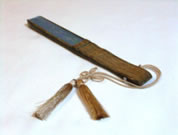

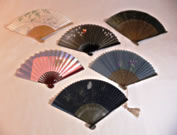
Tekagami (手かがみ)
Te=Hand, Kagami=Mirror
This is not really a traditional item but we would like to introduce present Japanese culture.
Many Japanese people (especially women) carry a handy pocket mirror for fashion.
Men use the handy pocket mirrors for fixing eye contact lens, and women use for make-up.
Suitable for personal use and for a gift.
